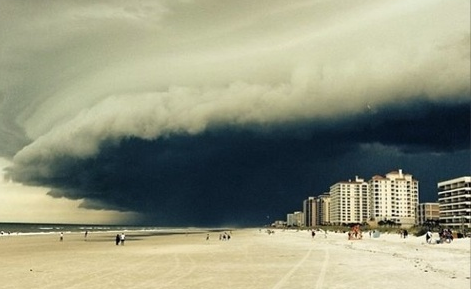This May Make You Think Twice Before Dancing In The Rain
In the photo below, there are people standing on a beach as an ominous storm approaches.The question is, “Why aren’t they getting out of the way of the storm?” In a similar vein, on July 11th, two Firestorm Principals, Rob and Jennifer Freedman, were driving through Rocky Mountain National Park (RMNP) on their way to the annual Hot Air Balloon Rodeo in Steamboat Springs, Colorado. Afternoon thunderstorms are common in the Rockies this time of year, and locals (defined as folks familiar with living in and around the mountains) are aware of this. That familiarity means that locals try very hard to avoid being out in the open up in the mountains after roughly noon.
Rob and Jennifer found themselves stuck in a traffic jam that lasted two hours. The traffic jam was caused by emergency responders reacting to lightning striking a group of hikers. Unlike the people on the beach, these hikers had seen the thunderstorm building and were hurrying back down the hiking trail to get out of danger. They had gotten nearly to the trailhead when the group was struck. Unfortunately, one woman was killed and several other members of the group sustained serious injuries, including broken bones.
This tragic event has frightening similarities to many business and operations scenarios. Organizational leaders know that disruptions happen – just as the people on the beach know there is a storm on the horizon. Like the people on the beach, some leaders are not taking action to “get out of the rain.” They are taking the position that the storm won’t hit them.
Other organizational leaders, like the hikers in RMNP, see the storm coming and know that it could hit them, but they wait too long to react and move to “get out of the rain.” Some organizations will survive their “lightning strike” by luck as the uninjured hikers did. Some organizations will sustain serious injuries from which they may or may not every fully recover. Some organizations, like the unfortunate woman on July 11th, will not survive.
It’s important to recognize that had the hikers turned around sooner and safely gotten back to their vehicles on the 11th, they may still have been struck by lightning. They may have experienced fatalities – but those are not the odds. Luck does favor the prepared, and hope is, in fact, neither a plan nor a strategy.
Just as it pays enormous dividends to be prepared when hiking in the Rocky Mountains, it pays those same kinds of dividends to be prepared in business. Predict the likely threats, identify the impacts, develop plans to mitigate or respond to those threats, identify triggers to act in time, and perform. Lastly, get out of the rain without getting wet, or at worst with a plan to get into warm dry clothes.
Ensure your business is prepared for any disaster by reading the Firestorm Business Continuity Self-Assessment.
 “What should we do now?” “What should we say?”
“What should we do now?” “What should we say?”